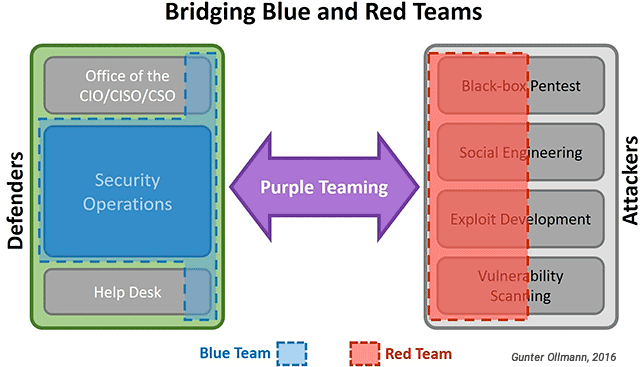It’s not particularly clear whether a marketing intern thought he was being clever or a fatigued pentester thought she was being cynical when the term “Purple Team Pentest” was first thrown around like spaghetti at the fridge door, but it appears we’re now stuck with the term for better or worse.
Just as the definition of penetration testing has broadened to the point that we commonly label a full-scope penetration of a target’s systems with the prospect of lateral compromise and social engineering as a Red Team Pentest—delivered by a “Red Team” entity operating from a sophisticated hacker’s playbook. We now often acknowledge the client’s vigilant security operations and incident response team as the “Blue Team”—charged with detecting and defending against security threats or intrusions on a 24x7 response cycle.
Requests for penetration tests (Black-box, Gray-box, White-box, etc.) are typically initiated and procured by a core information security team within an organization. This core security team tends to operate at a strategic level within the business—advising business leaders and stakeholders of new threats, reviewing security policies and practices, coordinating critical security responses, evaluating new technologies, and generally being the go-to-guys for out-of-ordinary security issues. When it comes to penetration testing, the odds are high that some members are proficient with common hacking techniques and understand the technical impact of threats upon the core business systems.
These are the folks that typically scope and eventually review the reports from a penetration test—they are however NOT the “Blue Team”, but they may help guide and at times provide third-line support to security operations people. No, the nucleus of a Blue Team are the front-line personnel watching over SIEM’s, reviewing logs, initiating and responding to support tickets, and generally swatting down each detected threat as it appears during their shift.
Blue Teams are defensively focused and typically proficient at their operational security tasks. The highly-focused nature of their role does however often mean that they lack what can best be described as a “hackers eye view” of the environment they’re tasked with defending.
Traditional penetration testing approaches are often adversarial. The Red Team must find flaws, compromise systems, and generally highlight the failures in the targets security posture. The Blue Team faces the losing proposition of having to had already secured and remediated all possible flaws prior to the pentest, and then reactively respond to each vulnerability they missed—typically without comprehension of the tools or techniques the Red Team leveraged in their attack. Is it any wonder that Blue Teams hate traditional pentests? Why aren’t the Red Team consultants surprised that the same tools and attack vectors work a year later against the same targets?

A Purple Team Pentest should be thought of as a dynamic amalgamation of Red Team and Blue Team members with the purpose of overcoming communication hurdles, facilitating knowledge transfer, and generally arming the Blue Team with newly practiced skills against a more sophisticated attacker or series of attack scenarios.
How to Orchestrate a Purple Team Pentest Engagement
Very few organizations have their own internal penetration testing team and even those that do, regularly utilize external consulting companies to augment that internal team to ensure the appropriate skills are on hand and to tackle more sophisticated pentesting demands.
A Purple Team Pentest almost always utilizes the services of an external pentest team—ideally one that is accomplished and experienced in Red Team pentesting.
Bringing together two highly skilled security teams—one in attack, the other in defense—and having them not only work together, but to also achieve all the stated goals of a Purple Team pentest, requires planning and leadership.
To facilitate a successful Purple Team Pentest, the client organization should consider the following key elements:
- Scope & Objectives – Before reaching out and engaging with a Red Team provider, carefully define the scope and objectives of the Purple Team Pentest. Be specific as to what the organization’s primary goals are and what business applications or operational facilities will be within scope. Since a key objective of conducting a Purple Team Pentest is to educate and better arm the internal Blue Team and to maximize the return on a Red Team’s findings, identify and list the gaps that need to be addressed in order to define success.
- Blue Team Selection – Be specific in defining which pieces of the organization and which personnel constitute the “Blue Team”. Go beyond merely informing various security operations staff that they are now part of a Blue Team. It is critical that the members feel they are a key component in the company’s new defensive strategy. Educate them about the roles and responsibilities of what the Blue Team entails. Prior to engaging with a Red Team provider and launching a Purple Team Pentest, socialize and refine the scope and objectives of the proposed Purple Teaming engagement with the team directly.
- Red Team Selection – It is important that the client select a Red Team that consists of experienced penetration testers. The greater the skills and experience of the Red Team members, the more they will be able to contribute to the Purple Team Pentest objectives. Often, in pure Red Team Pentest engagements, the consulting team will contain a mix of experienced and junior consultants—with the junior consultants performing much of the tool-based activities under the supervision of the lead consultant. Since a critical component of a Purple Team Pentest lies in the ability to communicate and educate a Blue Team to the attacker’s methodologies and motivations, junior-level consultants add little value to that dialogue. Clients are actively encouraged to review the resumes of the consultants proposed to constitute the Red Team in advance of testing.
- Playbook Definition – Both sides of the Purple Teaming exercise have unique objectives and methodologies. Creation of a playbook in advance of testing is encouraged and so too is the sharing and agreement between the teams. This playbook loosely defines the rules of the engagement and is largely focused on environment stability (e.g. rules for patch management and rollout during the testing period) and defining exceptions to standard Blue Team responses (e.g. identifying but not blocking the inbound IP addresses associated with the Red Team’s C&C).
- Arbitrator or Referee – Someone must be the technical “Referee” for the Purple Team Pentest. They need to be able to speak both Red Team and Blue Team languages, interpret and bridge the gap between them, manage the security workshops that help define and resolve any critical threat discoveries, and generally arbitrate according to the playbook (often adding to the playbook throughout the engagement). Ideally, the arbitrator or referee for the engagement is not directly associated with, or a member of, either the Red or Blue teams.
- Daily Roundtable Reviews – Daily round-table discussions and reviews of Red Team findings are the centerpiece of a successful Purple Team Pentest. Best conducted at the start of each day (mitigating the prospect of long tired days and possible overflow of working hours—curtailing discussion), the Red Team lays out the successes and failures of the previous days testing, while the Blue Team responds with what they detected and how they responded. The review facilitates the discussion of “What and Why” the Red Team members targeted, explain the “How” they proceeded, and allows the Blue Team to query and understand what evidence they may have collected to detect and thwart such attacks. For example, daily discussions should include discussions covering what traffic did the tool or methodology generate, where could that evidence have been captured, how could that evidence be interpreted, what responses would pose the biggest hurdle to the attacker?
- Pair-down Deep Dives – Allowing members of the teams to “pair down” after the morning review to dive deeper into the technical details and projected responses to a particular attack vector or exploitation is highly encouraged.
- Evaluate Attack and Defense Success in Real-time – Throughout the engagement, the “Arbitrator” should engage with both teams and be constantly aware of what attacks are in play by the Red Team, and what responses are being undertaken by the Blue Team. In some attack scenarios, it may be worthwhile allowing the Red Team to persist in an attack even if it has been detected and countered by the Blue Team, or is known to be unsuccessful and unlikely to lead to compromise. However, the overall efficiency can be increased and the cost of a Purple Team Pentest can be reduced by brokering conversations between the teams when attack vectors are stalled, irrelevant, already successful, or known to eventually become successful. For example, the Red Team are able to get a foothold on a compromised host and then proceed to brute-force attack the credentials of an accessible internal database server. Once the Red Team have successfully started their brute-force attack it may be opportune to validate with the Blue Team that they have already been alerted to the attack in process and are initiating countermeasures. At that point in time, in order to speed up the testing and to progress with another approved attack scenario, a list of known credentials are passed directly to the Red Team and they may progress with a newly created test credential on that (newly) compromised host.
- Triage and Finding Review – Most Red Team pentests will identify a number of security vulnerabilities and exploit paths that were missed by the Blue Team and will require vendor software patches or software development time to remediate. In a pure Red Team Pentest engagement, a “Final Report” would be created listing all findings—with a brief description of recommended and generic best practice fixes. In a Purple Team Pentest, rather than production of a vulnerability findings report, an end-of-pentest workshop should be held between the two teams. During this workshop each phase of the Red Team testing is reviewed—discoveries, detection, remediation, and mitigation—with an open Q&A dialogue between the teams and, at the conclusion of the workshop, a detailed remediation plan is created along with owner assignment.
The Future is Purple
While the methodologies used in Purple Team penetration testing are the same as those of a stand-alone Red Team Pentest, the business objectives and communication methods used are considerably different. Even though the Purple Team Pentest concept is relatively new, it is an increasingly important vehicle for increasing an organizations security stature and reducing overall costs.
The anticipated rewards from conducting a successful Purple Team pentest include increased Blue Team knowledge of threats and adversaries, muscle-memory threat response and mitigation, validation of playbook response to threats in motion, confidence in sophisticated attacker incident response, identification and enumeration of new vulnerabilities or attack vectors, and overall team-building.
As businesses become more aware of Purple Teaming concepts and develop an increased understanding of internal Blue Team capabilities and benefits, it is anticipated that many organizations will update their annual penetration testing requirements to incorporate Purple Team Pentest as a cornerstone of their overall information security and business continuity strategy.
NORDVPN DISCOUNT - CircleID
x NordVPN
Get NordVPN
[74% +3 extra months, from $2.99/month]










